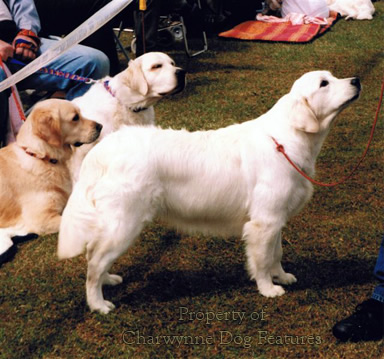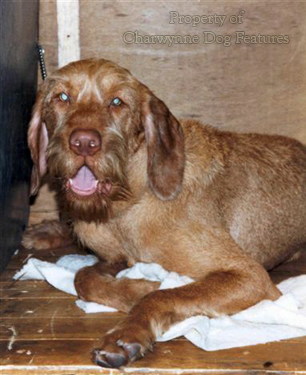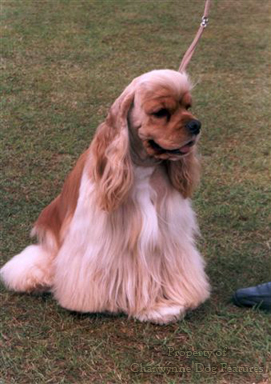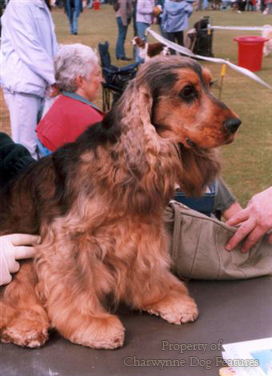689A Gundogs On Parade – Showing Off Our Gundog
Gundogs On Parade – Showing Off Our Gundog
by David Hancock
“Clever people soon fancied there was ‘money in’ the showing of so-called sporting dogs; and the show type strayed farther and farther from the lines of the old working pointer, until it touched the bottom about 1880, when the show-men, ignorant of the first principles of the pointer, could actually believe and applaud a writer who dared to sum him up thus:- ‘How can I better describe him than by saying he should be formed to a great extent on the model of the foxhound.’ (The Dog, Idstone, p.118). But by this time, Shows had multiplied like fever-rash – dog-showing had become a commercial profession – and doubtless the admixture of alien blood, alloying the gold, was found necessary to a dog that had to bear the constant strain of the show-bench. But what was the Kennel Club doing all that time, may be asked! Nothing, absolutely nothing.”
William Arkwright in his The Pointer and his Predecessors, 1906.
Show Ring Shortcomings
The annual Crufts Dog Show displays our gundogs, not the types that work best but each breed and its beau ideal. As I have previously stressed in other articles, it claims to exhibit 'the best of the very best'. As I have written earlier, on the 2012 event, the judges's critiques from recent shows hardly support that however. More concerning however are the remarks made by the judges at Crufts 2011 on construction and therefore movement: Labrador Retrievers – “Quite a few dogs that presented a glorious outline standing but reminded me more of a ‘Robin Reliant’ on the move as they crossed their legs coming or were almost single-tracking going away. In front movement much of this can be put down to shortness and straightness of the upper arm.” Italian Spinoni – “Movement overall was poor…” Chesapeake Bay Retrievers – “…the same problem of close hind movement remains…” Nova Scotia Duck Tolling Retrievers – “I still found many with short upper arms which gave a short mincing action…” Bracchi Italiani – “Heads were a cause for concern along with movement…Regretfully, I had to make the very difficult decision to withhold in both of the Puppy classes and from one exhibitor in a Junior class.” For a judge to withhold prizes at Crufts doesn’t give you much confidence in the qualifying system set up by the Kennel Club.
Worrying comments from the 2010 show’s judges include these: Cocker Spaniel dogs: “…I can only conclude…some had achieved qualification merely by virtue of being present.” Flat-coated Retriever dogs: “I was really worried about the front movement in the younger classes, they were all over the place with pinning front gait or else flicking out from the pasterns” and bitches: “I am worried that some of the hind movement was not positive, with the hocks having no power, also some of the front movement was not the best I have seen and this was not solely due to lack of exercise.” English Setters: “…a lot of exhibits were not as well-muscled as they should be, with flabby, soft rear ends and no second thigh muscle. An English Setter is a gundog and needs the exercise that will give them the required ‘well muscled’ hindquarters required in the standard.” Golden Retrievers: “…we should watch for over angulation…the back legs should be under the body, not sweeping way behind…too much angulation is no more or less a fault than too little.” Irish Red and White Setters: “…many Setters were completely splay-footed; at times I had to overlook this ugly fault in an otherwise sound specimen.” Not encouraging! 
Here are some from the 2009 Crufts show on gundogs: GSPs – “…many of the exhibits had very short muzzles and broad skulls…I also noticed in many of the younger classes the appearance of long thin legs with no substance or width over the rump, very strange. If these faults are not corrected we are going to lose the appearance of the GSP and it will be unable to do the job it was bred to do.” Hungarian Vizslas – “Heads of correct type and proportions were hard to find, short muzzles, snipy and lacking underjaw, round eyes and harsh expressions sadly becoming the norm.” Irish Setters – “Movement continues to concern, mostly from behind and the lack of muscle-tone was staggering in this active breed.” Pointers – “The movement on the majority of these dogs and bitches was quite unbelievable, from crossing in front, upright in pasterns, upright in shoulders and it became very soul-destroying watching so many bad unsound movers…How some of these bitches qualified for Crufts I will never know.” If the Crufts entry represents the best gundogs in the pedigree dog world, bring back the dropper!
Working Dog Presence
In the early days of Crufts, the Gamekeepers’ Ring there was one of the busiest; the Gamekeepers’ Association used to hold their Annual General Meeting at the show. But by the time gundogs as a Group had their own day at the show in 1987, the entries for the gamekeeper classes were low, with only 7 for Labrador and Curly-coated Retrievers, none for Flat-coats and Goldies, six for Any Variety Sporting Spaniel and 14 for Any Variety Gundog. In 1990, the BASC took over the running of the Gamekeepers’ Ring and still do, introducing in time both new classes and trophies, including team events and young handler classes. They very commendably introduced classes for dogs that have worked regularly in the shooting field, with 140 entries in 2011 in working classes alone. The ‘Northesk Memorial Trophy For Best Gundog’ is held in the main arena and only winners from the gamekeeper classes can compete for it. Here the working anatomy is on parade.
Undesired Obesity 
A regular comment from show ring judges in 2009 on the gundog entry was the exhibiting of overweight dogs, especially Labradors. Obesity in any working dog is a sin and any sensible judge should send such a dog to the back of the class, however shiny the coat. Labradors have long been known to be "gross feeders", liable to put on flesh. Being overweight inhibits field performance and places needless extra demands on the heart of the dog. Extra demands are also made by the construction faults listed by the 2009 Crufts judges. Unsound movement, especially when rooted in incorrectly placed shoulders which limits endurance through the additional strain imposed on the forequarters. Setters can be racey but should never lack muscle-tone. Strength in the back and limbs is fundamental for stamina on a long day in the shooting field. Such basic faults are of course present too in working dogs but no sensible owner breeds from such stock. Winners at Crufts produce scores of offspring.
For the owner of even a show gundog not to keep his dog in good physical condition is a betrayal of the working origin of the breed. Crufts judges's reports in the recent past on Field and Clumber Spaniels respectively read: "...many were shown carrying too much weight" and "I felt many were in soft condition..." This source of criticism from show ring judges on gundog breeds is not restricted to Crufts; at the North West Labrador Club's Championship show of 1996, the judge reported: "There can't have been more than 20 bitches (in a high entry) who were a suitable weight for a working breed." At the 2012 Manchester Championship Show, the Flat-coat judge reported, after lamenting the lack of hindquarter muscle: “Several really nice dogs were shown overweight…” Obesity, however undesirable in a gundog breed, is easily rectified, faulty movement indicates faulty construction, which is much more worrying.
Importance of Word Pictures
A Crufts-winning Pointer with a high-stepping, forward-reaching Hackney action, which I once witnessed, was in fact in breach of its own breed standard, as promulgated by the Kennel Club which runs Crufts and appoints judges. This standard states very plainly..."Definitely not a hackney action...Any departure from the foregoing points should be considered a fault..." So here was a specimen of one of our most famous gundog breeds winning at our most prestigious dog show of the year with an easily-identified fault. What is the point of having a precisely-worded standard if a dog can win in spite of it? What kind of gundog judge is it that cannot see such a basic fault in a working dog?
Other judges of show ring gundogs are not slow to spot significant faults as these critiques from judges illustrate. North Riding Gundog Club's open show: "I was appalled at the unsound action, especially in Golden Retrievers and Labradors, many of which looked so nice standing but fell to pieces on the move." Other judges looking over Labradors at different shows wrote: "The diversity of type and the prevalence of coarse heads and poor tails gives cause for concern for the future"..."My main criticism is mouths. I found 5 from all the classes which were really bad"..."I would like to mention incorrect mouths. I have never come across so many variations before and some were quite severely wrong." A gundog's mouth is rather important! These remarks by judges were made about dogs bred to a carefully-written standard and change hands for several hundreds of pounds.
Overlooked Flaws 
A recent show critique on the Irish Setter used these words: "Many had short necks or rather, the neck was the correct length, if only the shoulders and forequarters had been angulated correctly, ...a fault that is being accepted as the correct standard...I hope the two entropians are not bred from." Here are pedigree gundogs being bred with not only a fault in their basic construction but with faulty genes too! In-growing eyelashes or entropian is a distressing eye condition in any breed; yet dogs suffering from this inherited defect can be shown under Kennel Club rules and win prizes. What a situation - gundog breeders knowingly perpetuating physically unsound dogs!
A well-known Labrador breeder, who prides herself on her dual-purpose dogs, once complained that the scheme to identify hip dysplasia in the breed was doing enormous damage to working Labradors. I would have thought that hip dysplasia was doing a certain amount of damage in the breed too! The desperately worrying situation over inherited diseases in dogs will only be changed through the fullest cooperation of all breeders. I would like to see the Kennel Club stipulate that all breeding stock must have their hips scored if their offspring are to be registered. What really is the point of spending two years training a dog to a good field standard only to find it disabled by a inherited defect?
Fit for what Function?
It is depressing however for any admirer of dogs that can work to read a prominent KC member declare a few years back that people don't want their terriers to go to ground, their Border Collies to herd sheep or their gundogs to retrieve game, they just want pets. What a betrayal of trust, an admission of defeat! A breed that is not physically able to carry out its original task has no right to bear the name of that breed. It is not a question of whether it has to but whether it is able to undertake its historic role, indeed, whether it is truly a member of that historic breed at all. Do we really want retrievers with no capability for retrieving?
Of course, there are some excellent gundogs at Crufts and there are excellent breeders of dual-purpose gundogs too. What we need to do is reject from the show ring, not even allow them to be exhibited, dogs with the kind of structural flaws highlighted by the top show ring judges themselves. It’s not good enough for them just to go cardless; they should thrown out of the ring, before the judging even starts. A dog show is a livestock show or it is nothing. Dogs that qualify for Crufts with blatant faults represent a severe judgement on the show ring judges who provided them with qualification. In the wake of that admirable TV programme Pedigree Dogs Exposed, quite remarkable changes are being made in the show dog world. After the sad and predictable attempts to ‘shoot the messenger’ rather than heed the message, immediately after that hard-hitting programme, the Kennel Club has grasped the nettle over such serious matters as excessive exaggeration in many breeds and I give them credit for that. The Bateson Report on dog-breeding in the UK will in time benefit pedigree gundogs, whether worked or shown.
Commendably, the Kennel Club is at last striving to perpetuate a working anatomy on its entries; they ask for fitness for function, they ask for gundog judges to attend field trials. Over the last century the KC has not done all it could to perpetuate the working capabilities of the revered breeds of pedigree dog entrusted to its custodianship. Gundogs were developed over many centuries by dedicated master-breeders to perform to a high standard in the field; to be worthy of the responsibility now entrusted to our generation, we simply have to perpetuate these breeds in their time-honoured mould. Many superb working dogs make excellent pets. All dogs kept as pets are spiritually happier if their instinctive behaviour is exercised.
Role of the Show Ring
The KC studbook should never merely be a register of births but a record of sound stock. How else can dog owners wishing to own purebred animals be given a service for their registration fee? A livestock studbook has to be much more than a breeding record; domestic animals are not free to choose their mates. We cannot elect to do that for them unless we act responsibly. It is surely not acceptable for pedigree gundogs to win in the show-ring and yet be carriers of inherited diseases. This situation has been tolerated for far too long and must now cease. It is also highly undesirable for dogs with glaring faults to be placed by judges lacking knowledge of functional animals. Gundogs in the conformation show-ring, where working qualities cannot be tested, really must move correctly and movement itself must be placed higher than any other judging point. Over the next few years, it will be illuminating to study the critiques of the gundog judges at Crufts and see what real progress is being achieved at the top of the pedigree dog world. I am more hopeful now than for several decades. Our gundog breeds deserve the very best custodianship.
Inspiration from Quality
When I was making a commercial video on the Labrador Retriever some years ago, I had the pleasure and privilege of seeing the dogs in the kennels of the late Gwen Broadley and, later, of Carole Coode. It was abundantly clear that both these breeders had a very clear idea of what an outstanding dog in their breed should look like. I think of them when I see overweight faulty Labs at shows and in the park. I am old enough too to recall the consistently-high quality of the 'of Ware' Cockers and the Whitwell Pointers. Top quality dogs can be truly inspiring. But you shouldn’t have to rely on your memory to be conscious of top quality gundogs, they should be all around you – from inspired breeders, identified by competent judges and valued by experienced sportsmen.
In his valuable two-volume The Dog Book of 1906, the under- rated Scottish writer, James Watson, describes quite scathingly those in the world of purebred dogs who fail to realise that a pedigree is only a piece of paper. He records a conversation with the great Irish Terrier breeder of one hundred years ago, William Graham, who cast his eye over a show entry of his time and declared: 'Some men show pedigrees; I show dogs and take the prizes.' Vero Shaw, the distinguished canine authority of that time, gave the view in a show report that, all too often, the pedigree was worth more than the dog. And to this day, you still hear an indifferent animal excused on the grounds that it 'has a good pedigree'. As James Watson observed: ‘No one with any knowledge of the subject will breed to a dog merely on pedigree...a good dog makes a pedigree good, and not the other way.’
Reading Pedigree Forms
There used to be a saying in dog breeding circles: No animal is well-bred unless it is good in itself. I haven't heard it spoken of as a received wisdom for some years. Much more important than the names on the written pedigree is the ability to 'read' it, translate the names into physical content. As the great Scottish Terrier breeder, WL McCandlish wrote in his book on the breed: 'The names in a pedigree form are merely cyphers, designating certain groupings of features and certain sources of blood, and pedigree is of no value unless the breeder can translate what these cyphers mean. ' Yet even some quite experienced dog breeders get dazzled by names on forms, rather than by dogs, supported by blood from distinct ancestors. The eminent canine geneticist Malcolm Willis has written: 'Never does pedigree information become more important than information on the dog itself.' We must always value dogs that are good in themselves. 
Perhaps highly significant statements such as 'No animal is well-bred unless it is good in itself', 'Never does pedigree information become more important than information on the dog itself', 'Some men show pedigrees; I show dogs' and 'a good dog makes the pedigree good, and not the other way' need to be given greater impact. The phrase 'become purely a fancier's dog' need not become immediately associated with deterioration, but be an acknowledgement that that breed is best-bred - and has wide-ranging thoroughly-comprehensive KC-certification to indicate that. Quality assurance surely has to be the name of this purebred dog game. Show me the form - of the dog!
I believe that the award of champion status in gundogs has lost its value, in times when pedigree dogs often have to be protected from poor standards – of breeding, judging and amongst exhibitors. The title of champion should only be awarded after the dog has subsequently passed tests for temperament, carriage of inherited defects, inbreeding coefficients and morphology (i.e. harmful physical features, as at Crufts from 2012). The bestowing of champion status should only be awarded in a gundog breed after the dog has gained a working certificate at a working test in the field. The title of Champion really must mean something; cheap rosettes, and a superficial title such as Show Champion, lead to unworthy dogs being bred from; a free for all in breeding doesn’t benefit a breed; unreliable temperament presents an unwanted problem for the buying public – the pet market. Our dogs need protecting from bad breeders. Truly committed breed fanciers should welcome a title actually bringing all-round soundness with it, not just a name casually recorded in a stud book. If you are proud of your breed, why not strive for the very best stock?
“The practical shooting man might well wonder what the pace of some of the fastest and most brilliant dogs would dwindle down to at the end of a long day on grouse. This staying power is the foundation of almost the most essential part of a pointer or setter, for a heavy-shouldered or slack-loined dog would be unable from his conformation to maintain pace and style in rough heather in Scotland, or over rough ground in the south; and yet on a brief trial such a dog might take a higher place than he would justify on a longer test. In America, the greatest attention and credit is paid to stamina and the consequent ability to maintain pace and style, and rightly so, as without this knowledge it is impossible to breed on correct lines.”
Major Maurice Portal, writing in the Lonsdale Library’s Shooting by Moor, Field and Shore, Seeley Service & Co.Ltd., 1929.
“It is an undoubted fact that the major part of the sporting dogs exhibited have never been tested on game, but are merely specimens of external form…It is remarkable what numbers of miserable specimens often obtain prizes…you must bear in mind that the value of a dog does not consist in the number of prizes he may have taken at shows, but in the quality of his stock, and if he has improved the breed.”
Edward Laverack, writing in his The Setter, Longmans, Green, and Co., 1872.
“I do not wish to suggest for a moment that as a dog-show club pure and simple the Kennel Club has done amiss, for (again like Gallio) it appears to police its kingdom effectually enough, and its registration of dogs’ names and pedigrees is emphatically a benefit to all. It is as a guardian of the English working-dogs, and as a bulwark against the seething whirlpools of ‘fancy’, that it has proved such a failure.”
William Arkwright in his The Pointer and his Predecessors, 1906.